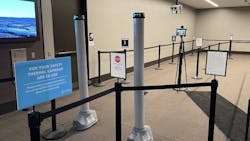AUSTIN, Texas – April 1, 2024 - Athena Security has announced the addition of “Evasion Detection” to its set of features from best practices from Homeland Security. In crowded entryways, visitors sometimes try to elude the screening process, be it out of haste, unfamiliarity, or ill intent. Powered by artificial intelligence (AI), the Evasion Detection locates individuals who attempt to bypass weapons detection portals while entering a facility or area.
Evasion Detection is included in Athena’s most current systems. The feature now assists the screening process in healthcare institutions, schools, casinos, stadiums, hotels, jewelry stores, houses of worship, and other Athena customers and partners.
Advanced AI is among the many elements that differentiate Athena from other WDS companies. Beyond evasion detection, Athena’s solution also deploys AI to ensure that wanding procedures and techniques comply with best practices from the Department of Homeland Security.
Athena also leverages AI to ensure that bags undergo proper inspection and that the visitor is sent back through the portal when necessary.
Athena systems also comply with the NILECJ-STD-0601.00 Level 1 and 2 Security Standard for detection performance.
“All of these AI enhancements serve our goal of having organizations run their entryways safely,” said Chris Ciabarra, Athena’s Co-Founder and Chief AI Architect. “Sometimes screeners get tired or forgetful, or overwhelmed by people entering a facility. The new features detect when screening procedures vary from documented best practices and remind the officers on duty of proper system operation.”
Athena cofounder and President Lisa Falzone added that the innovations stemmed both from customer requests and Athena’s own iteration processes. “We continually work with our clients to identify areas where enhanced automation can further improve safety without sacrificing user convenience,” she said. These latest additions resulted from cumulatively observing and testing client entry screening for hundreds of hours.



